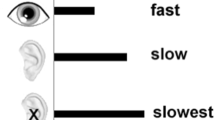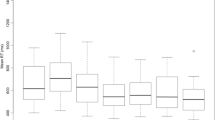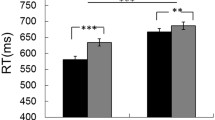Abstract
Extending previous evidence for attentional shifts across auditory and visual modalities without the confound of the two modalities originating at different locations (Turatto et al. 2002), we investigated attention shifts between auditory and tactile modalities, and between tactile and visual modalities. Two stimuli (S1 and S2), either in the same or in different modalities, were delivered from the same spatial source and were separated by a variable temporal gap. S1 was task irrelevant, whereas S2 required a speeded discrimination. Results showed that modality switching is detrimental independently of the stimulated modality as long as the temporal lag between S1 and S2 is short enough that there is not time to switch attention before S2 is delivered. We observed automatic, modality-driven, attentional capture, with ipsimodal trials leading to faster response times than crossmodal trials. The present results cannot be accounted for by spatial artifacts, response priming or criterion shifts, and are interpreted as the consequence of a space-independent attentional shift across sensory modalities.




Similar content being viewed by others
References
Arnell KM, Jolicoeur P (1999) The attentional blink across stimulus modalities: evidence for central processing limitation. J Exp Psychol Hum Percept Perform 25:630–648
Bridgeman B (1988) The biology of behavior and mind. Wiley, Oxford
Caclin A, Soto-Faraco S, Kingstone A, Spence C (2002) Tactile “capture” of audition. Percept Psychophys 64:616–630
Clark HH, Fox Tree J (2002) Using uh and um in spontaneous speaking. Cognition 84:73–111
Corbetta M, Miezen FM, Dobmeyer S, Shulman GL, Petersen SE (1991) Selective and divided attention during visual discriminations of shape, color, and speed: functional anatomy by positron emission tomography. J Neurosci 11:2383–2402
Dell’Acqua R, Turatto M, Jolicoeur P (2001) Crossmodal attentional deficits in processing tactile stimulation. Percept Psychophys 63:777–789
Driver J, Spence C (1994) Spatial synergies between auditory and visual attention. In: Umiltà C, Moscovitch M (eds) Attention and performance XV: conscious and nonconscious information processing. MIT Press, Cambridge, MA, pp 311–331
Driver J, Spence C (1998) Attention and the crossmodal construction of space. Trends Cog Sci 7:254–262
Driver J, Spence C (2000) Multisensory perception: beyond modularity and convergence. Curr Biol 10:R731–R735
Eimer M, Schröger E (1998) ERP effects of intermodal attention and cross-modal links in spatial attention. Psychophysiology 35:313–327
Eimer M, Van Velzen J (2002) Crossmodal links in spatial attention are mediated by supramodal control processes: evidence from event-related potentials. Psychophysiology 39:437–449
Farah MJ, Wong AB, Monheit MA, Morrow LA (1989) Parietal lobe mechanisms of spatial attention: modality-specific or supramodal? Neuropsychologia 27:461–470
Harvey N (1980) Non-informative effects of stimuli functioning as cues. Q J Exp Psychol A 32:413–425
Johnston JC, McCann RS, Remington RW (1995) Chronometric evidence for two types of attention. Psychol Sci 6:365–369
Jolicoeur P (1999) Restricted attentional capacity between sensory modalities. Psychon Bull Rev 6:87–92
Jonides J (1981) Voluntary versus automatic control over the mind’s eye’s movement. In: Long JB, Baddeley AD (eds) Attention and performance IX. Erlbaum, Hillsdale, NJ, pp 187–203
Kawashima R, O’Sullivan BT, Roland PE (1995) Positron-emission tomography studies of cross-modality inhibition in selective attentional tasks: closing the “mind’s eye”. Proc Natl Acad Sci U S A 92:5969–5972
Kennett S, Eimer M, Spence C, Driver J (2001) Tactile-visual links in exogenous spatial attention under different postures: convergent evidence from psychophysics and ERPs. J Cog Neurosci 13:462–468
Klein RM (1977) Attention and visual dominance: a chronometric analysis. J Exp Psychol Hum Percept Perform 3:365–378
Logan GD (1980) Attention and automaticity in Stroop and priming tasks: theory and data. Cognit Psychol 12:523–553
McDonald JJ, Ward LM (2000) Involuntary listening aids seeing: evidence from human electrophysiology. Psychol Sci 11:167–171
Müller HJ, Rabbitt PMA (1989) Reflexive and voluntary orienting of visual attention: time course of activation and resistance to interruption. J Exp Psychol Hum Percept Perform 15:315–330
Pashler H (1994) Dual-task interference in simple tasks: data and theory. Psychol Bull 116:19–45
Posner MI (1980) Orienting of attention. Q J Exp Psychol A 32:3–25
Posner MI, Petersen SE (1990) The attention system of the human brain. Annu Rev Neurosci 13:25–42
Posner MI, Nissen MJ, Klein RM (1976) Visual dominance: an information-processing account of its origins and significance. Psychol Rev 83:157–171
Posner MI, Snyder CRR, Davidson BJ (1980) Attention and the detection of signals. J Exp Psychol Gen 109:160–174
Rogers RD, Monsell S (1995) Costs of predictable switch between simple cognitive tasks. J Exp Psychol Gen 124:207–231
Schmitt M, Postma A, de Haan E (2000) Interactions between exogenous auditory and visual spatial attention. Q J Exp Psychol A 53:105–130
Spence C (2001) Crossmodal attentional capture: a controversy resolved? In: Folk CL, Gibson BS (eds) Attraction, distraction, and action: multiple perspectives on attentional capture. North Holland, Amsterdam, pp 231–262
Spence C (2002) Multisensory attention and tactile information processing. Behav Brain Res 135:57–64
Spence C, Driver J (1996) Audiovisual links in endogenous covert spatial attention. J Exp Psychol Hum Percept Perform 22:1005–1030
Spence C, Driver J (1997a) Audiovisual links in exogenous covert spatial orienting. Percept Psychophys 59:1–22
Spence C, Driver J (1997b) On measuring selective attention to an expected sensory modality. Percept Psychophys 59:384–403
Spence C, Driver J (2000) Attracting attention to the illusory location of a sound: reflexive crossmodal orienting and ventriloquism. Neuroreport 11:2057–2061
Spence C, Lloyd D, McGlone F, Nicholls MER, Driver J (2000a) Inhibition of return is supramodal: a demonstration between all possible pairings of vision, touch, and audition. Exp Brain Res 134:42–48
Spence C, Pavani F, Driver J (2000b) Crossmodal links between vision and touch in covert endogenous spatial attention. J Exp Psychol Hum Percept Perform 26:1298–1319
Stein BE, Wallace MT, Meredith MA (1995) Neural mechanisms mediating attention and orientation to multisensory cues. In: Gazzaniga MS (ed) The cognitive neurosciences. MIT Press, Cambridge, MA, pp 683–702
Stein BE, London N, Wilkinson LK, Price DP (1996) Enhancement of perceived visual intensity by auditory stimuli: a psychophysical analysis. J Cog Neurosci 8:497–506
Tassinari G, Berlucchi G (1995) Covert orienting to non-informative cues: reaction-time studies. Behav Brain Res 71:101–112
Tassinari G, Campara D (1996) Consequences of covert orienting to non-informative stimuli of different modalities: a unitary mechanism? Neuropsychologia 34:235–245
Turatto M, Benso F, Galfano G, Umiltà C (2002) Nonspatial attentional shifts between audition and vision. J Exp Psychol Hum Percept Perform 28:628–639
Van Selst M, Jolicoeur P (1994) A solution to the effect of sample size on outlier elimination. Q J Exp Psychol A 47:631–650
Ward LM (1994) Supramodal and modality-specific mechanisms for stimulus-driven shifts of auditory and visual attention. Can J Exp Psychol 48:242–259
Ward LM, McDonald JJ, Golestani N (1998) Crossmodal control of attention shifts. In: Wright RD (ed) Visual attention. Oxford University Press, New York, NY, pp 232–268
Ward LM, McDonald JJ, Lin D (2000) On asymmetries in crossmodal spatial attention orienting. Percept Psychophys 62:1258–1264
Author information
Authors and Affiliations
Corresponding author
Additional information
The research was supported by grants from CNR and MURST to C.U.
Rights and permissions
About this article
Cite this article
Turatto, M., Galfano, G., Bridgeman, B. et al. Space-independent modality-driven attentional capture in auditory, tactile and visual systems. Exp Brain Res 155, 301–310 (2004). https://doi.org/10.1007/s00221-003-1724-x
Received:
Accepted:
Published:
Issue Date:
DOI: https://doi.org/10.1007/s00221-003-1724-x




